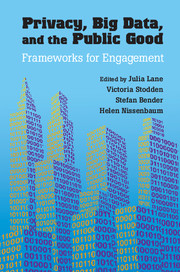Book contents
- Frontmatter
- Dedication
- Contents
- Contributors
- Editors’ Introduction
- Part I Conceptual Framework
- Part II Practical Framework
- 6 The Value of Big Data for Urban Science
- 7 Data for the Public Good: Challenges and Barriers in the Context of Cities
- 8 A European Perspective on Research and Big Data Analysis
- 9 The New Deal on Data: A Framework for Institutional Controls
- 10 Engineered Controls for Dealing with Big Data
- 11 Portable Approaches to Informed Consent and Open Data
- Part III Statistical Framework
- References
8 - A European Perspective on Research and Big Data Analysis
Published online by Cambridge University Press: 05 July 2014
- Frontmatter
- Dedication
- Contents
- Contributors
- Editors’ Introduction
- Part I Conceptual Framework
- Part II Practical Framework
- 6 The Value of Big Data for Urban Science
- 7 Data for the Public Good: Challenges and Barriers in the Context of Cities
- 8 A European Perspective on Research and Big Data Analysis
- 9 The New Deal on Data: A Framework for Institutional Controls
- 10 Engineered Controls for Dealing with Big Data
- 11 Portable Approaches to Informed Consent and Open Data
- Part III Statistical Framework
- References
Summary
Introduction
Chapters 6 and 7 have highlighted the research potential of large datasets, particularly those which derive from administrative systems, monitoring devices, and customer databases, outlining the legal, ethical, and practical issues involved in gaining access to and linking between such data for research with potentially wide social and economic value. While the focus in these earlier chapters has been primarily upon the development of such data as research resources within the United States, many of the legal and ethical issues outlined have wider relevance. Here the focus shifts to an examination of a number of these matters from a European perspective.
A clearly stated ambition within Europe is to create a research environment (the European Research Area) in which research interests are promoted via cross-border access to microdata, free from legal constraints and other obstacles which form impediments to this ambition such as the languages used and differences in the scientific culture of research. This chapter explores the legal obstacles to wider cross-border data access for researchers based in different European countries and illustrates with examples how these are being addressed. The chapter is presented in two parts. The first part gives an historical overview of the progress that has been made across Europe to develop a harmonised approach to legislation designed to provide individuals and organisations with what has become known as the ‘right to privacy’. It charts the immediate postwar efforts to establish the right to a private life and traces the impact this has had in terms of the use for research of electronic records containing personal information. In so doing an attempt is made not simply to highlight the forces that have helped shape the new legislation that the European Union (EU) is about to introduce, but to address the question as to what constitutes ‘misuse of personal data’ in terms of privacy concerns and to gauge how important this is for European citizens.
- Type
- Chapter
- Information
- Privacy, Big Data, and the Public GoodFrameworks for Engagement, pp. 173 - 191Publisher: Cambridge University PressPrint publication year: 2014
References
- 6
- Cited by



